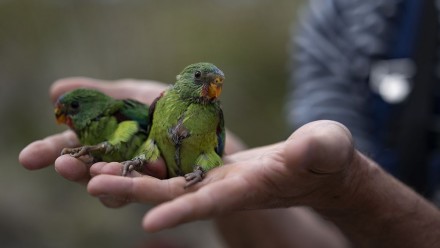Belinda Wilson

Contacts
Belinda is a conservation ecologist in the Coexistence Conservation Lab specialising in threatened species translocations. Her experiences in research, consultancy, and environmental regulation have led to a keen interest in combining fundamental science with management actions. In particular, she investigates how integrating our understanding of animal behaviour, spatial ecology, community associations, and ecosystem processes can improve conservation outcomes.
Research interests
Belinda conducts research across four broad topics: translocation science, community dynamics, threatened species monitoring, and ecological restoration. In particular, she investigates how iteratively adopting strategies and tactics within an adaptive management framework can improve conservation outcomes. I advocate for incorporating ecological theory into conservation planning, and work with practitioners to inform management.
During her doctorate, she conducted extensive research on eastern quoll reintroduction biology, including their translocation tactics, behavioural ecology, spatial ecology, and species recovery. The eastern quoll reintroduction formed part of the Australian Research Council-funded Bringing Back Biodiversity project within the long-term Mulligans Flat–Goorooyarroo Woodland Experiment (a major collaborative effort between ANU, ACT Government, and Woodlands and Wetlands Trust), which also supported successful reintroductions and genetic management of eastern bettongs, bush stone-curlews, and New Holland mice.
- Wilson (2023) Reintroduction biology of the eastern quoll (Dasyurus viverrinus). PhD thesis, The Australian National University, November 2023.
- Read et al. (2023) Havens are a pathway, not an endpoint, for species recovery: A response to Woinarski et al. (2023). Biological Conservation, 285: 110212.
- Evans et al. (2023) Trends in animal translocation research. Ecography, e06528.
- Wilson et al. (2022) Roadmap to recovery revealed through the reintroduction of an IUCN Red List species. Biodiversity and Conservation, 32: pp 227–248.
- Evans et al. (2022) Reintroduction biology and the IUCN Red List: The dominance of species of Least Concern in the peer-reviewed literature. Global Ecology and Conservation, 38: e02242.
- Evans et al. (2022) Coexistence conservation: reconciling threatened species and invasive predators through adaptive ecological and evolutionary approaches. Conservation Science and Practice, 4(7): e12742.
- Wilson et al. (2022) Personality and plasticity predict post-release performance in a reintroduced mesopredator. Animal Behaviour, 187: pp 177–189.
- Wilson et al. (2021) Reintroduction of the eastern quoll to Mulligans Flat Woodland Sanctuary, Australia, using trials, tactics, and adaptive management. In book: Soorae (ed. 2021) Global conservation translocation perspectives 2021: Case studies from around the globe (pp 194–199). IUCN SSC Conservation Translocation Specialist Group, Environment Agency, and Calgary Zoo.
- Wilson et al. (2020) Adapting reintroduction tactics in successive trials increases the likelihood of establishment for an endangered carnivore in a fenced sanctuary. PLOS One, 15(6): e0234455.
- Portas et al. (2020) Baseline health and disease assessment of founder eastern quolls (Dasyurus viverrinus) during a conservation translocation to mainland Australia. Journal of Wildlife Diseases, 56(3): pp 1–14.
- Wilson (2013) Investigating the spatial behaviour of leopard seals (Hydrurga leptonyx) in relation to Antarctic pack-ice dynamics. Honours thesis, University of New South Wales, November 2013.










